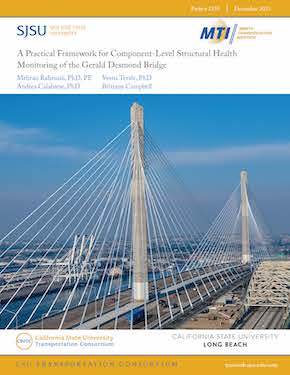- 408-924-7560
- mineta-institute@sjsu.edu
- Donate
A Practical Framework for Component-Level Structural Health Monitoring of the Gerald Desmond Bridge
Bridges serve as critical transportation infrastructure, but traditional maintenance inspection to ensure their safety is time-consuming, costly, and labor-intensive, especially for larger and more complex structures. This study presents a practical framework for the instrumentation, data acquisition, and remote condition assessment of the Gerald Desmond Bridge, California’s largest cable-stayed bridge. The framework aims to establish a foundation for real-time or near real-time remote health monitoring of the bridge’s critical elements. Through a comprehensive literature review, best practices and recent advancements in sensing technologies and instrumentation strategies utilized in similar cable-stayed bridges worldwide were examined. The study emphasizes the importance of understanding the bridge’s load path, structural redundancy, and the failure mechanisms of critical elements to design an effective monitoring regime. The proposed instrumentation includes a wide range of cutting-edge and sustainable monitoring sensors, addressing challenges related to data acquisition for a large sensing network. A set of requirements was gathered to guide the design process, covering wireless sensing technologies, local response monitoring, scalability, cable tension analysis, energy-saving techniques, fatigue life estimation, and compensation for thermal effects. Element-specific instrumentation and layout designs tailored to the critical elements of the bridge were proposed. The study highlights the advantages of remote monitoring in terms of efficiency, cost-effectiveness, and early detection of damage. Verification and calibration of the sensing network are crucial steps, involving field tests, data analysis, and the determination of thresholds for healthy or anomalous responses. The study underscores the importance of these verifications and calibrations in enhancing the system’s reliability and accuracy for early damage detection.
MEHRAN RAHMANI, PHD, PE
Dr. Mehran Rahmani is an Associate Professor in the Civil Engineering and Construction Management (CECEM) Department of California State University Long Beach (CSULB). He earned a PhD in Structural and Earthquake Engineering from the University of Southern California (USC) in 2014, an MS in Electrical Engineering (with an emphasis in Signal Processing) from USC in 2013, and an MS in Structural Engineering from Sharif University of Technology (Iran) in 2009. Prior to joining CSULB, Dr. Rahmani, a registered Professional Engineer (PE) in the state of California, worked as a Senior Engineer and as a Project Engineer in the structural engineering industry from 2014 to 2017. Dr. Rahmani’s research focuses on structural system identification, structural health monitoring, and earthquake damage detection of buildings and bridges using sensory data. His PhD research focused on developing a wave-based methodology for remote post-earthquake structural damage detection that is robust when applied to actual structures and is calibrated using data from full-scale buildings. The research project was funded by the National Science Foundation (NSF). He was instrumental in the advances in wave-based structural identification and monitoring in the past 15 years.
VESNA TERZIC, PHD
Dr. Vesna Terzic is an Associate Professor in the CECEM department at CSULB. Dr. Terzic has conducted research related to transportation infrastructure for the past 15 years. Her research focuses on experimental and analytical investigations of the seismic performance of highway bridges. Dr. Terzic has vast experience in developing robust and high-fidelity nonlinear models of overpass bridges. She has significantly contributed to developing analytical models for evaluating the traffic capacity of bridges in damaged conditions. She has recently developed a novel method for probabilistic evaluation of the post-earthquake functionality of bridges.
ANDREA CALABRESE, PHD
Dr. Andrea Calabrese is an Associate Professor in the CECEM department at CSULB. Dr. Calabrese earned his PhD in Construction Engineering with an emphasis in Structural Engineering in 2013. He was a visiting research fellow at the Pacific Earthquake Engineering Research Center (PEER) from 2010–12 and a postdoctoral researcher of the ReLUIS Consortium, The Italian Network of University Laboratories in Earthquake Engineering, from 2013–2014. He worked as a Structural Engineer at Foster & Partners, London, and has been a registered engineer in Italy since 2009 and a Chartered Engineer (CEng) and Full Member of the Institution of Civil Engineers (MICE) in the UK since 2017. Dr. Calabrese's current research interests are in the fields of experimental testing, structural dynamics, base isolation, vibration engineering and in the development of novel low-cost devices for the seismic protection of bridges and buildings.
BRITTANY CAMPBELL, BS. CE
Brittany Campbell received her BS in civil engineering from California State University, Long Beach. She served as a Research Assistant on this project. Brittany will commence her Master’s in Business Administration (MBA) at the CSULB in the Fall 2023.
-
Contact Us
San José State University One Washington Square, San Jose, CA 95192 Phone: 408-924-7560 Email: mineta-institute@sjsu.edu






